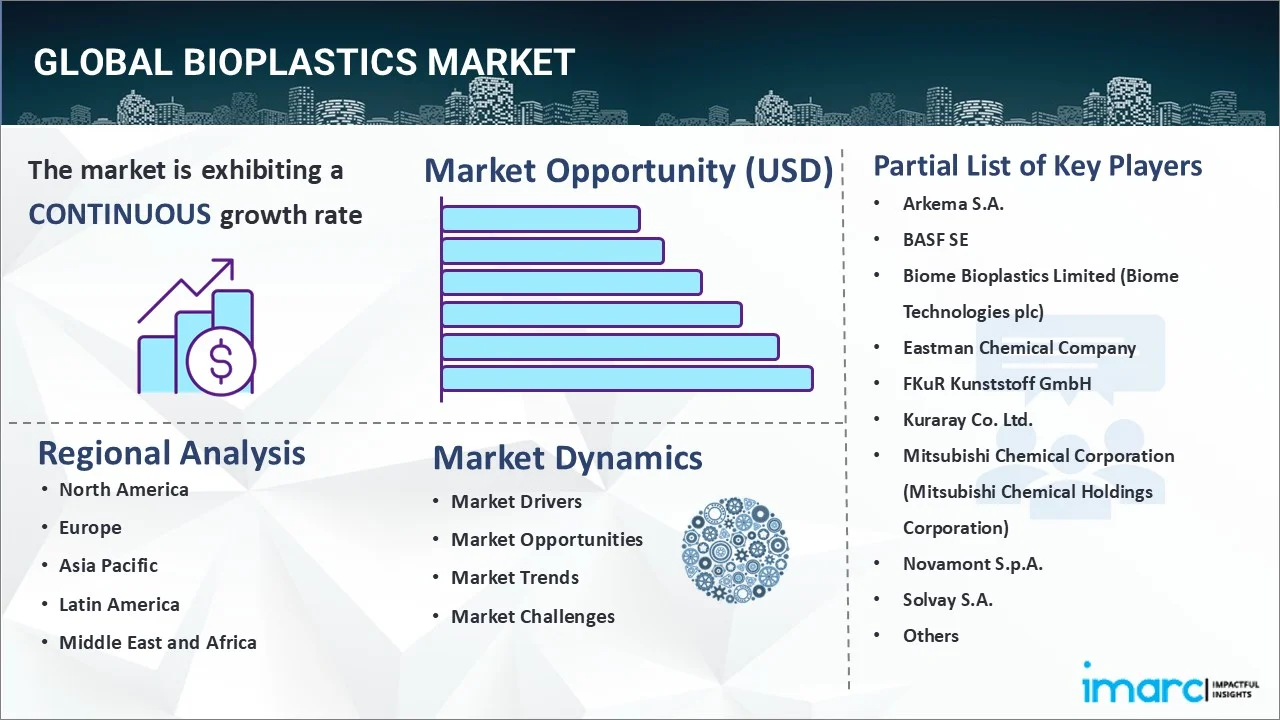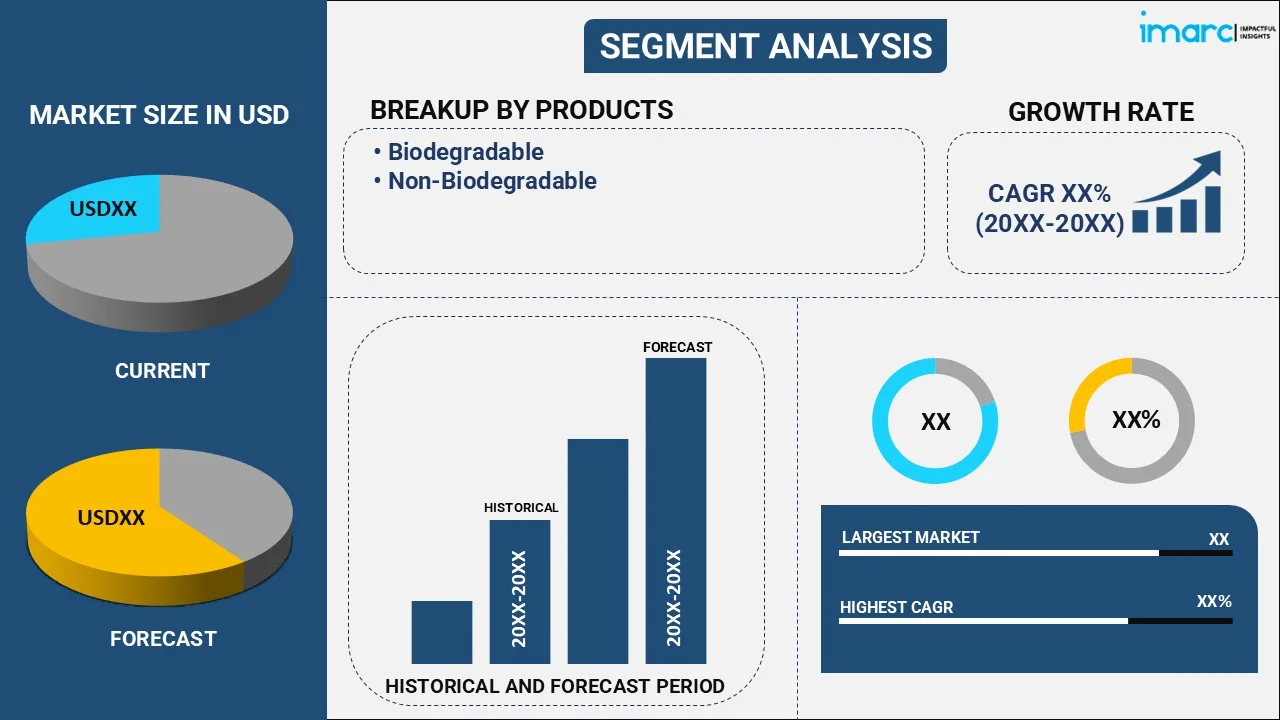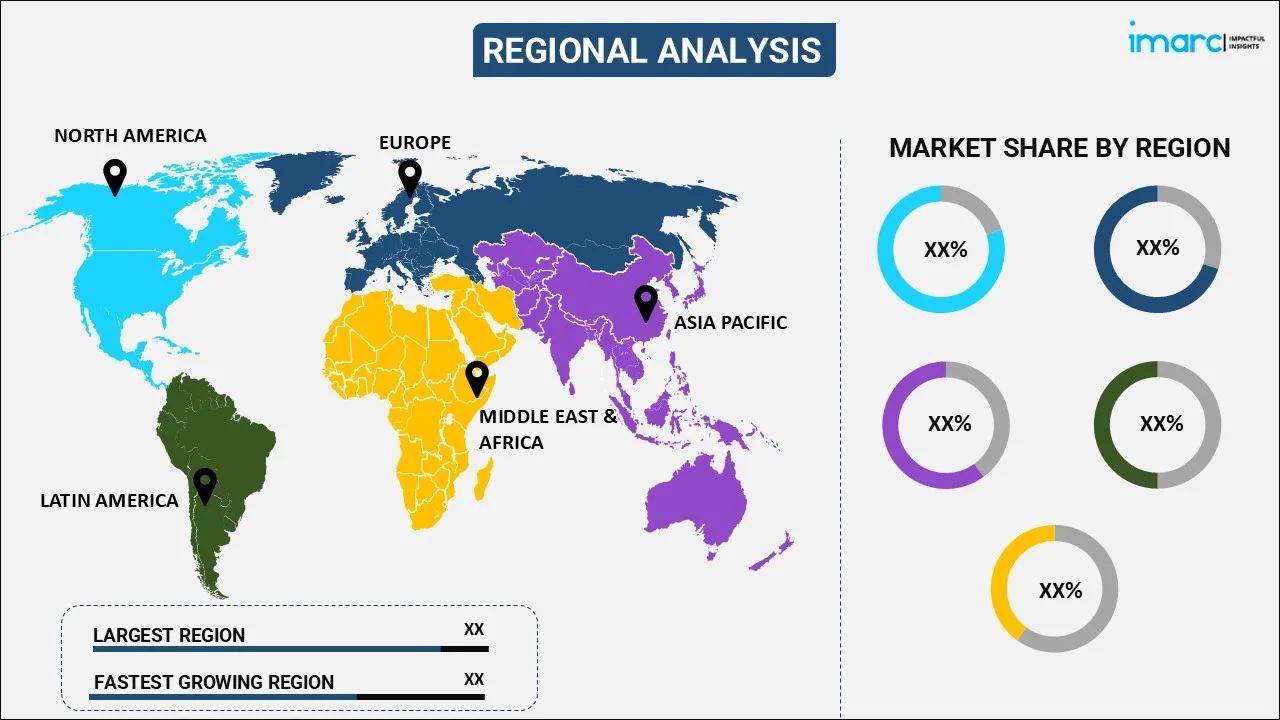
Bioplastics Market Report by Product (Biodegradable, Non-Biodegradable), Application (Flexible Packaging, Rigid Packaging, Agriculture and Horticulture, Consumer Goods, Textile, Automotive and Transportation, and Others), Distribution Channel (Online, Offline), and Region 2025-2033
Global Bioplastics Market:
The global bioplastics market size reached USD 13.9 Billion in 2024. Looking forward, IMARC Group expects the market to reach USD 33.3 Billion by 2033, exhibiting a growth rate (CAGR) of 10.18% during 2025-2033. The growing awareness of environmental sustainability among the masses, the implementation of stricter regulations concerning waste management and emissions, and the rising preference for eco-friendly products are among the key factors driving the market growth.
|
Report Attribute
|
Key Statistics
|
|---|---|
|
Base Year
|
2024 |
|
Forecast Years
|
2025-2033 |
|
Historical Years
|
2019-2024
|
|
Market Size in 2024
|
USD 13.9 Billion |
|
Market Forecast in 2033
|
USD 33.3 Billion |
| Market Growth Rate 2025-2033 | 10.18% |
Bioplastics Market Analysis:
- Major Market Drivers: The growing awareness regarding environmental sustainability and the subsequent regulatory support are primarily driving the growth of the market. In line with this, the rising preference for eco-friendly products and increasing awareness about climate change and plastic pollution are also contributing to the market growth.
- Key Market Trends: The development of new bioplastic materials with enhanced properties, such as improved durability and heat resistance, is a key trend in the bioplastics market, expanding their applicability in various industries, such as healthcare, agriculture, textiles, and 3D printing.
- Geographical Landscape: According to the report, Europe exhibited the largest market segment. This can be attributed to the unique blend of regulatory support, consumer awareness, and technological innovation. Furthermore, the European Union has been at the forefront of environmental legislation, implementing directives that aim to reduce plastic waste.
- Competitive Landscape: Some of the leading bioplastics market companies operating in the global market are Arkema S.A., BASF SE, Biome Bioplastics Limited (Biome Technologies plc), Eastman Chemical Company, FKuR Kunststoff GmbH, Kuraray Co. Ltd., Mitsubishi Chemical Corporation (Mitsubishi Chemical Holdings Corporation), Novamont S.p.A., Solvay S.A., Teijin Limited, Total Corbion PLA, and Trinseo, among many others.
- Challenges and Opportunities: The bioplastics market faces challenges related to the cost of production and limited scalability of bioplastic materials. However, opportunities exist in the form of increasing environmental concerns, which drive the demand for sustainable alternatives to traditional plastics. Technological advancements and innovations in bioplastic production also present opportunities for market growth.

Bioplastics Market Trends:
Rising Environmental Concerns
A significant factor driving the market is the rising environmental issues, which are encouraging various industries to shift from plastics to bioplastics. Furthermore, the rising efforts of the government authorities of various nations to reduce landfilling, such as the U.S. 2030 Food Loss and Waste Reduction Goal, are augmenting the demand for bio-based bags or compostable bags used in the collection of food leftovers and other organic waste. Similarly, the implementation of the single-use plastic ban worldwide and an ambitious biomanufacturing initiative by the Government of India are serving as a facilitating driver for bioplastics production. In addition to this, ten states, including California, Connecticut, Delaware, Hawaii, Maine, New Jersey, New York, Oregon, Vermont, and Washington, had some form of statewide ban on single-use plastic bags as of 2023, and bans in Colorado and Rhode Island went into effect on the first day of 2024. Such initiatives are further catalyzing the bioplastics market share.
Continuous Technological Advancements
Technological innovation is another significant driver bolstering the bioplastics market. Moreover, advances in polymer science, material engineering, and manufacturing processes are resulting in the development of bioplastics that are increasingly comparable to their petroleum-based counterparts in terms of performance and cost. In addition to this, various leading players are entering into partnerships and forming collaborations to leverage advanced technologies for bioplastic production. For instance, in March 2024, Sulzer Ltd. signed a deal to supply its cutting-edge polylactic acid (PLA) production technologies to Balrampur Chini Mills Limited (BCML) to support the construction of India’s first bioplastics plant. The new state-of-the-art bioplastics plant will produce 75,000 tons of compostable, wholly recyclable bioplastic per year using sugarcane as a feedstock. Furthermore, various companies are innovating with waste products to turn them into bioplastics and reduce environmental pollution, which is propelling the bioplastics market revenue. For instance, the bioplastics company PlantSwitch turns at least 30 million pounds of agricultural waste into 50 million pounds of bioplastic pellets each year.
Increasing Application in the Food Industry
The rising adoption of flexible bioplastics in the food and beverage sector is also creating a positive outlook for the overall market. Bioplastics made of cornstarch have applications in flexible and loose-fill packaging. Moreover, the increasing demand for ready-to-cook food packages on account of the hectic lifestyles of consumers, the growing working population across the globe, and the inflating spending capacities of consumers are also augmenting the bioplastics market demand for packaging purposes. Revenue in the ready-to-eat meals market is projected to reach US$ 1.02 Billion in 2024. The market is likely to increase to twofold by 2025. Similarly, Germany's food and beverage industry is characterized by its small and medium-sized enterprise sector of over 6,000 companies. The revenue in the food and beverage market was estimated at US$ 3,222 Million in 2021. The market is expected to grow significantly in the coming years, driving the country's flexible and rigid packaging industry and bioplastic consumption.
Bioplastics Industry Segmentation:
IMARC Group provides an analysis of the key trends in each segment of the bioplastics market report, along with forecasts at the global, regional and country levels from 2025-2033. Our report has categorized the market based on product, application and distribution channel.
Breakup by Product:

- Biodegradable
- Polylactic Acid
- Starch Blends
- Polybutylene Adipate Terephthalate (PBAT)
- Polybutylene Succinate (PBS)
- Others
- Non-Biodegradable
- Polyethylene
- Polyethylene Terephthalate
- Polyamide
- Polytrimethylene Terephthalate
- Others
Biodegradable holds the largest market share
The report has provided a detailed breakup and analysis of the market based on the product. This includes biodegradable (polylactic acid, starch blends, polybutylene adipate terephthalate (PBAT), polybutylene succinate (PBS), and others), and non-biodegradable (polyethylene, polyethylene terephthalate, polyamide, polytrimethylene terephthalate, and others). According to the report, biodegradable accounted for the largest market share.
Biodegradable plastics are plastics that can be decomposed by the action of living organisms, usually microbes, into water, carbon dioxide, and biomass. As per the bioplastics market overview, the demand for biodegradable bioplastics is driven by several key market forces that emphasize sustainability and waste management. Moreover, governments worldwide are instituting bans or limitations on single-use, non-biodegradable plastics, creating a policy-driven demand for alternatives. For instance, the European Union (EU) is taking a significant step towards reducing plastic waste by banning single-use plastics by 2030. This initiative is part of a broader plan to make packaging more sustainable across the EU. In line with this, experts warned that plastic pollution in the ocean could triple by 2040 if urgent action isn't taken. In 2022, UN members agreed to develop a treaty to end plastic pollution, with negotiations currently ongoing. Such initiatives are augmenting the market for biodegradable plastics.
Breakup by Application:
- Flexible Packaging
- Rigid Packaging
- Agriculture and Horticulture
- Consumer Goods
- Textile
- Automotive and Transportation
- Others
Flexible packaging accounts for the majority of the market share
A detailed breakup and analysis of the market based on the application has also been provided in the report. This includes flexible packaging, rigid packaging, agriculture and horticulture, consumer goods, textile, automotive and transportation, and others. According to the report, flexible packaging accounted for the largest market share.
The bioplastics market forecast by IMARC, indicates that the market for bioplastics in flexible packaging applications is experiencing robust growth, propelled by a combination of consumer behavior, sustainability imperatives, and technological advancements. Bioplastics are used in flexible packaging as they are not harmful to nature and are easily degradable. They are widely used in packaging films for food items, medicines, beverage bottles, and packaging films. As per a report by Packmedia, in 2021, the world market for flexible converter packaging was estimated at US$ 102 Billion, up 8% from the previous year. Moreover, various market players are investing in the manufacturing of flexible bioplastic packaging to cater to the bolstering demand. For instance, in March 2024, Aldi implemented AI in its stores to track flexible plastic packaging collected from the public via its front-of-store collection points. The technology will show how much flexible plastic is sorted and into which polymers, how much is reprocessed, and into what end products.
Breakup by Distribution Channel:
- Online
- Offline
The report has provided a detailed breakup and analysis of the market based on the distribution channel. This includes online and offline.
The rise of online distribution channels is a significant market driver for the bioplastics industry. With the increasing trend of e-commerce, there is a surging demand for packaging materials that are both efficient and sustainable. Bioplastics meet this need, as they offer the requisite durability for shipping while being derived from renewable sources.
On the other hand, the offline distribution channel remains a crucial market driver for the bioplastics industry, especially in sectors like retail and food service. Regulatory factors play a significant role as local and national governments are increasingly banning or restricting the use of single-use plastics in stores and restaurants, thereby positively impacting the bioplastics market outlook.
Breakup by Region:

- North America
- United States
- Canada
- Asia-Pacific
- China
- Japan
- India
- South Korea
- Australia
- Indonesia
- Others
- Europe
- Germany
- France
- United Kingdom
- Italy
- Spain
- Russia
- Others
- Latin America
- Brazil
- Mexico
- Others
- Middle East and Africa
Europe exhibits a clear dominance, accounting for the largest bioplastics market share
The market research report has also provided a comprehensive analysis of all the major regional markets, which include North America (the United States and Canada); Asia Pacific (China, Japan, India, South Korea, Australia, Indonesia, and others); Europe (Germany, France, the United Kingdom, Italy, Spain, Russia, and others); Latin America (Brazil, Mexico, and others); and the Middle East and Africa. According to the report, Europe exhibited the largest market segment.
As per the bioplastics market statistics by IMARC, the Europe market for bioplastics is witnessing significant growth, which can be attributed to the unique blend of regulatory support, consumer awareness, and technological innovation. Furthermore, the European Union has been at the forefront of environmental legislation, implementing directives that aim to reduce plastic waste. Besides this, Italy's packaging industry is one of the largest in the world. There are nearly 7,000 significant and minor packaging companies active in the country. The growing importance of supermarket retailing and the changing consumer purchasing habits are increasing the packaging demand in the country. Additionally, various key market players in the region are investing in bioplastics manufacturing plants. For instance, in August 2022, BASF Venture Capital GmbH, the corporate venture company of BASF SE, Germany, and Aqua-Spark, a Dutch investment fund, invested in Sea6 Energy Pvt. Ltd. Sea6 Energy is a leader in the production and processing of tropical red seaweed. Sea6 Energy is also working on developing bioplastics and biofuels based on red seaweed. Such investments are anticipated to bolster the bioplastics market recent price.
Competitive Landscape:
The market research report has provided a comprehensive analysis of the competitive landscape in the market. Detailed profiles of all major companies have also been provided. Some of the key players in the market include:
- Arkema S.A.
- BASF SE
- Biome Bioplastics Limited (Biome Technologies plc)
- Eastman Chemical Company
- FKuR Kunststoff GmbH
- Kuraray Co. Ltd.
- Mitsubishi Chemical Corporation (Mitsubishi Chemical Holdings Corporation)
- Novamont S.p.A.
- Solvay S.A.
- Teijin Limited
- Total Corbion PLA
- Trinseo
(Please note that this is only a partial list of the key players, and the complete list is provided in the report.)
Bioplastics Market Recent Developments:
- April 2024: Swedish bioplastics manufacturer Gaia Biomaterials successfully concluded a US$ 5 Million rights issue. The rights issued are backed by the Swedish state-owned greentech venture capital fund Almi Invest Greentech, and private international and domestic investors. Funds will be used to expand market penetration in the United States, India, and other targeted markets.
- April 2024: TotalEnergies Corbion presented Luminy PLA bioplastics in Shanghai at Chinaplas 2024, Asia's premier plastics and rubber trade fair. It also showcased how easily companies can transition to PLA bioplastics solutions and lower their products’ carbon emissions by up to 75% versus conventional plastic solutions.
- March 2024: Sulzer Ltd. agreed to supply its cutting-edge polylactic acid (PLA) production technologies to Balrampur Chini Mills Limited (BCML) to support the construction of India’s first bioplastics plant. The new state-of-the-art bioplastics plant will produce 75,000 tons of compostable, wholly recyclable bioplastic per year using sugarcane as a feedstock. It will be located adjacent to one of BCML’s sugar cane processing facilities, enabling BCML to use the country’s main agricultural crop to make a major contribution to the nation’s sustainability aims.
Bioplastics Market Report Scope:
| Report Features | Details |
|---|---|
| Base Year of the Analysis | 2024 |
| Historical Period | 2019-2024 |
| Forecast Period | 2025-2033 |
| Units | Billion USD |
| Scope of the Report | Exploration of Historical Trends and Market Outlook, Industry Catalysts and Challenges, Segment-Wise Historical and Predictive Market Assessment:
|
| Products Covered |
|
| Applications Covered | Flexible Packaging, Rigid Packaging, Agriculture and Horticulture, Consumer Goods, Textile, Automotive and Transportation, Others |
| Distribution Channels Covered | Online, Offline |
| Regions Covered | Asia Pacific, Europe, North America, Latin America, Middle East and Africa |
| Countries Covered | United States, Canada, Germany, France, United Kingdom, Italy, Spain, Russia, China, Japan, India, South Korea, Australia, Indonesia, Brazil, Mexico |
| Companies Covered | Arkema S.A., BASF SE, Biome Bioplastics Limited (Biome Technologies plc), Eastman Chemical Company, FKuR Kunststoff GmbH, Kuraray Co. Ltd., Mitsubishi Chemical Corporation (Mitsubishi Chemical Holdings Corporation), Novamont S.p.A., Solvay S.A., Teijin Limited, Total Corbion PLA, Trinseo, etc. |
| Customization Scope | 10% Free Customization |
| Post-Sale Analyst Support | 10-12 Weeks |
| Delivery Format | PDF and Excel through Email (We can also provide the editable version of the report in PPT/Word format on special request) |
Key Benefits for Stakeholders:
- IMARC’s industry report offers a comprehensive quantitative analysis of various market segments, historical and current market trends, market forecasts, and dynamics of the bioplastics market from 2019-2033.
- The research report provides the latest information on the market drivers, challenges, and opportunities in the global bioplastics market.
- The study maps the leading, as well as the fastest-growing, regional markets. It further enables stakeholders to identify the key country-level markets within each region.
- Porter's five forces analysis assist stakeholders in assessing the impact of new entrants, competitive rivalry, supplier power, buyer power, and the threat of substitution. It helps stakeholders to analyze the level of competition within the bioplastics industry and its attractiveness.
- Competitive landscape allows stakeholders to understand their competitive environment and provides an insight into the current positions of key players in the market.
Key Questions Answered in This Report
The global bioplastics market was valued at USD 13.9 Billion in 2024.
We expect the global bioplastics market to exhibit a CAGR of 10.18% during 2025-2033.
The increasing demand for eco-friendly and sustainable packaging solutions, such as bioplastic materials, as they are reusable and decompose faster, which aid in conserving natural resources and cutting down toxic waste, is primarily driving the global bioplastics market.
The sudden outbreak of the COVID-19 pandemic had led to the implementation of stringent lockdown regulations across several nations, resulting in the temporary halt in numerous production activities for bioplastics.
Based on the product, the global bioplastics market has been segregated into biodegradable and non-biodegradable. Currently, biodegradable holds the majority of the total market share.
Based on the application, the global bioplastics market can be bifurcated into flexible packaging, rigid packaging, agriculture and horticulture, consumer goods, textile, automotive and transportation, and others. Among these, flexible packaging exhibits a clear dominance in the market.
On a regional level, the market has been classified into North America, Asia-Pacific, Europe, Latin America, and Middle East and Africa, where Europe currently dominates the global market.
Some of the major players in the global bioplastics market include Arkema S.A., BASF SE, Biome Bioplastics Limited (Biome Technologies plc), Eastman Chemical Company, FKuR Kunststoff GmbH, Kuraray Co. Ltd., Mitsubishi Chemical Corporation (Mitsubishi Chemical Holdings Corporation), Novamont S.p.A., Solvay S.A., Teijin Limited, Total Corbion PLA, and Trinseo.
Need more help?
- Speak to our experienced analysts for insights on the current market scenarios.
- Include additional segments and countries to customize the report as per your requirement.
- Gain an unparalleled competitive advantage in your domain by understanding how to utilize the report and positively impacting your operations and revenue.
- For further assistance, please connect with our analysts.
 Inquire Before Buying
Inquire Before Buying
 Speak to an Analyst
Speak to an Analyst
 Request Brochure
Request Brochure
 Request Customization
Request Customization




.webp)




.webp)












